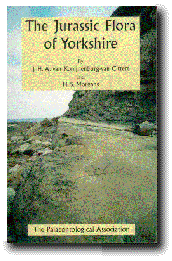The Jurassic Flora of Yorkshire
by J.H.A. van Konijnenburg-van Cittert and H.S. Morgans
Palaeontological Association, 1999, 134
p.
ISBN 0-901702-64-1; $24.00 U.S. or £ 12 U.K.
|
 |

With each generation of paleobotanists, new tools, new methods, and new
paradigms guide research. Now more than ever before, paleobotanists are
conducting research and collecting data not only on plant anatomy and
morphology, but also on the sedimentology, facies architecture, and
stratigraphic context of the fossil deposits. All of this information, combined
with the recognition and documentation of compositional variation on both small
spatial and temporal scales, has permitted more accurate reconstructions of the
paleoecology of the source vegetation. Although applied to new localities, “classic”
localities often go un-restudied in light of the new paradigms, despite their
importance.
The plant-bearing beds in the Middle Jurassic
Ravenscar Group of Yorkshire have been investigated for more than a century
and the 250+ species from over 600 beds have been described in numerous publications,
notably in Harris’ five volume set ( Harris 1961, 1964, 1969, 1979; Harris et
al. 1974). The authors of this field guide have selected four plant beds (Hasty
Bank, Hayburn Wicke, Gristhorpe, and Scalby Ness) and provided descriptions,
photographs, and keys to over 100 of the most commonly found species in these
beds.
The text is concise, without flourish, but with
enough detail to characterize and differentiate among the many taxa. Numerous
line drawings are used to clarify morphological features described in the text
and a glossary is provided for morphological terms employed in the descriptions
(one exception is “falcate: curving forward” which otherwise is defined
within the text). Without material in front of me, I usually find keys
impossible to read, but those provided are simple and straightforward. The most
important part of any guide to fossils is the photographs. The photographs are
abundant, with most species illustrated by at least one image. The photographs
are large enough and generally have sufficient contrast to show the necessary
details clearly.
Errors in the text are extremely few—I counted
only five. Two are related to figure referrals: Osmundopsis sturii is
referred to in text as Text-Fig. 17C, but is 17D (p.41); and Czekanowskia
microphylla is referred to in the text as Text-Fig.42C, but is 39C (p.107).
The others are even more minor.
If there is great value to this guide beyond the
taxonomic descriptions and images, and I believe there clearly is, it lies in
the addition of detailed stratigraphic sections that describe the lithologies,
sedimentary features, and facies interpretation that provide important and often
neglected context information for collectors – both amateur and professional.
Anyone approaching these beds will be prepared for what they will encounter, not
only in terms of the plants, but also the geology. The authors also provide a
very informative table that describes the distribution and relative abundance of
each plant species in each plant bed. Finally the authors conclude their guide
with a discussion of the paleoecology of the Ravenscar Group and the Yorkshire
plant fossil beds. The integration of plant distributions and facies
characteristics to form a classification system of the deposits provides an
informative synthesis of the nature and deposition of the original vegetation.
In view of that synthesis, if there is one thing missing from this guide, it is
illustrations of plant reconstructions. I realize that few have been completed,
and I can hardly fault the authors for their absence, but I can wish it
otherwise.
The authors are to be commended for compiling a
clear and instructive introduction to the fossil floras of the Yorkshire
Jurassic for collecting novices and veterans. Having completed this review, I am
compelled to point out that I have never been to these localities. But with this
guidebook, with the pictures, keys, maps, and stratigraphic sections it
contains, I am sure that I could easily locate these plant beds and identify
most of the fossils I collect. I hope one day to give this guide a true
test.


![]()